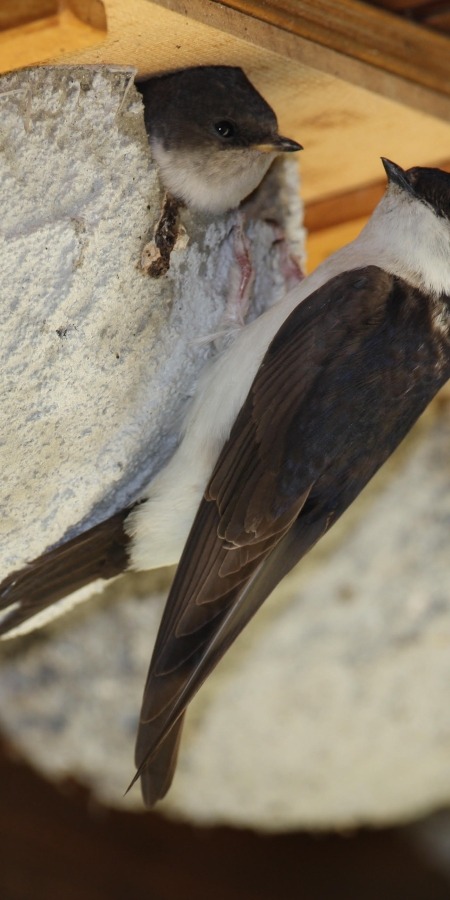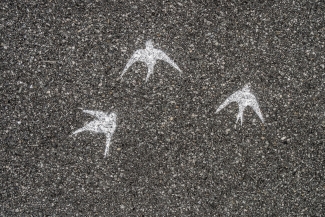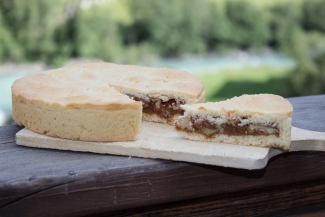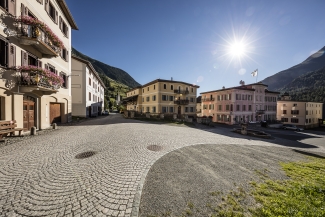Randulins
Of swallows and emigrants


Swallows in the Engadine
«The swallows, that's us,» says Randunella, «the acrobats of the air,» she adds. «I am a House Martin, we spend the winter in Africa, south of the Sahara. Every year, between the end of April and mid-May, we return to the Engadine, and to the rest of Switzerland, of course. There we either build a new nest on the facade of the house, preferably under the roof, move back into the one from last year or make the artificial nest homely, which some Engadine people have installed for us. Besides us, there are also the gray crag martins, which are the first to return from the south, and the barn swallows, which are easily recognized by their forked tails and the fact that they build their nests in old barns.»
But the swallows are also people, Randunella explains. «That was the name of the Engadine emigrants of the last centuries. Swallows because they were always homesick and therefore returned to the Engadine every summer. Just like us.»

Why sugar bakers?
«I'm not much for the sweet stuff. My preferences are clearly the small, crunchy gnats and flies, if I can still find some. It's not that easy anymore, because there are fewer and fewer... So the confectioners didn't get their skills from us. In fact, at that time no craftsmen emigrated, but mainly farmers. Because the craftsmen had work and income, the peasants only work but hardly earnings. They could be farmers, but that was of little use in a city. So it was good that they learned from their mothers how to make sweets and pastries, at least that's what an old woman told me. That's why they first hired on at bakeries, but were so successful that they took over some bakeries themselves right away and opened others. The Venetians couldn't handle this success and immediately drove all the Graubünden out of town.»

How the nut cake came to the Engadine
«The nut cake is also too sweet for me, but I still know its story, because I flew past Gaudenz Zimmermann's house the other day and heard it there. I thought to myself that this cake could not be an Engadine invention. In any case, I have never seen tree nuts in Engadin, hazelnuts have. France, however, is known for its nuts, I know that from my overflights: Not only in Grenoble are the trees close together, but also in the Périgord near Toulouse. And from Toulouse comes the nut cake from the Heinz + Tester confectionery. Since 1881, the two Graubünden made the specialty. The base actually a Fuatscha grassa, the filling of caramel, nuts and cream rather French, the lid again Engadine because Fuatscha Grassa. Her employee Fausto Pult from the Engadin, brought the recipe home to Samedan, from where it then began its triumphal procession.»

Architecture
«We shape the villagescapes of the Engadine and so do the human swallows.
Whenever possible, we stick our nests to the facades of houses and then feed our young in them, screaming loudly and performing as many daredevil flight maneuvers as possible. If it goes well, we can even raise two broods in one summer.»
The influence of the other swallows was especially great in the past and in the villages that burned down, Sent and Lavin for example. For quite a few of the emigrated confectioners made it to wealth and prosperity, but thanks to the Engadin folk disease homesickness («increschantüm») they were still strongly connected with their homeland. That is why they did not hesitate for a second after the fire catastrophes and sent money for the reconstruction to the Engadin, including their favorite master builders. Well, one of them also set up a monument and rubbed the others' noses in their economic success in a somewhat ostentatious manner.

Randulin Association
«We swallows are also somewhat creatures of habit. If possible, we return to our last nest every year. I hear that humans are very similar to us in that respect, except that they have a much shorter travel distance and therefore it's much easier to find the house again. The people are not only creatures of habit, but also sociable, which is why they have even founded an association of Randulins in Sent. Only those whose ancestors emigrated or who can prove a particularly great interest in the history of the Randulins may become members. The aim of the association is to promote sociability and to support the Randulins, to help them with inheritance matters or house purchases or sales, or to take care of cemetery concerns.»


